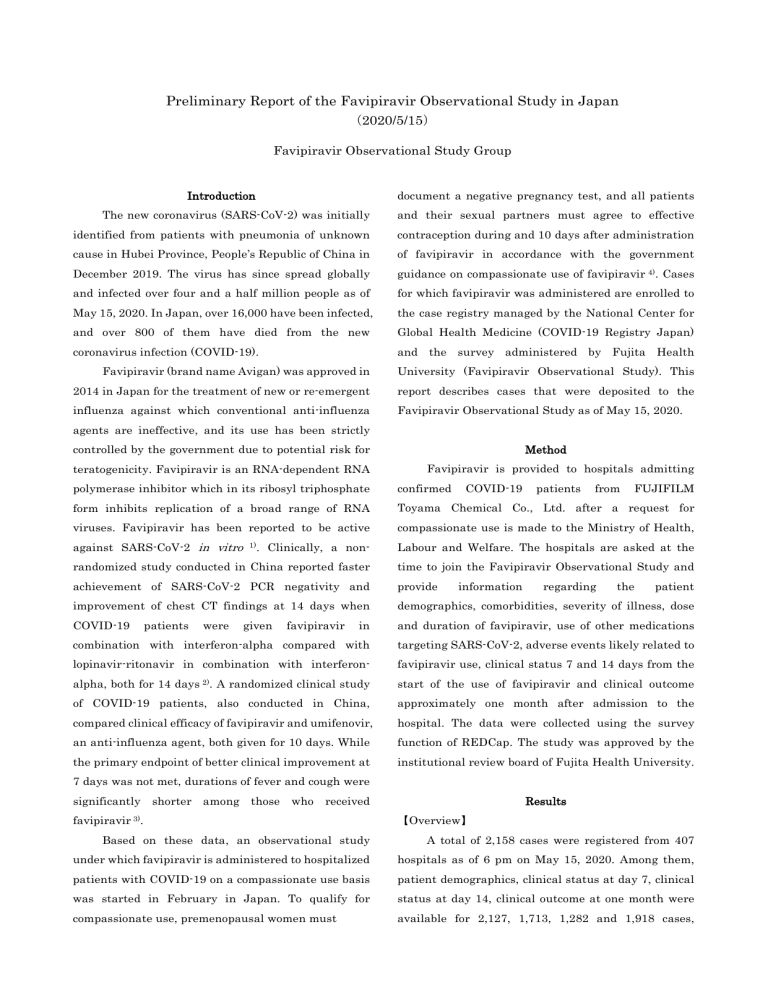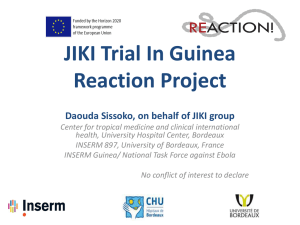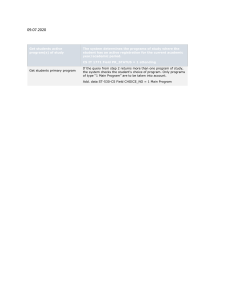
Preliminary Report of the Favipiravir Observational Study in Japan (2020/5/15) Favipiravir Observational Study Group Introduction document a negative pregnancy test, and all patients The new coronavirus (SARS-CoV-2) was initially and their sexual partners must agree to effective identified from patients with pneumonia of unknown contraception during and 10 days after administration cause in Hubei Province, People’s Republic of China in of favipiravir in accordance with the government December 2019. The virus has since spread globally guidance on compassionate use of favipiravir 4). Cases and infected over four and a half million people as of for which favipiravir was administered are enrolled to May 15, 2020. In Japan, over 16,000 have been infected, the case registry managed by the National Center for and over 800 of them have died from the new Global Health Medicine (COVID-19 Registry Japan) coronavirus infection (COVID-19). and the survey administered by Fujita Health Favipiravir (brand name Avigan) was approved in University (Favipiravir Observational Study). This 2014 in Japan for the treatment of new or re-emergent report describes cases that were deposited to the influenza against which conventional anti-influenza Favipiravir Observational Study as of May 15, 2020. agents are ineffective, and its use has been strictly Method controlled by the government due to potential risk for teratogenicity. Favipiravir is an RNA-dependent RNA Favipiravir is provided to hospitals admitting polymerase inhibitor which in its ribosyl triphosphate confirmed form inhibits replication of a broad range of RNA Toyama Chemical Co., Ltd. after a request for viruses. Favipiravir has been reported to be active compassionate use is made to the Ministry of Health, against SARS-CoV-2 in vitro Clinically, a non- Labour and Welfare. The hospitals are asked at the randomized study conducted in China reported faster time to join the Favipiravir Observational Study and achievement of SARS-CoV-2 PCR negativity and provide improvement of chest CT findings at 14 days when demographics, comorbidities, severity of illness, dose COVID-19 in and duration of favipiravir, use of other medications combination with interferon-alpha compared with targeting SARS-CoV-2, adverse events likely related to lopinavir-ritonavir in combination with interferon- favipiravir use, clinical status 7 and 14 days from the alpha, both for 14 days 2). A randomized clinical study start of the use of favipiravir and clinical outcome of COVID-19 patients, also conducted in China, approximately one month after admission to the compared clinical efficacy of favipiravir and umifenovir, hospital. The data were collected using the survey an anti-influenza agent, both given for 10 days. While function of REDCap. The study was approved by the the primary endpoint of better clinical improvement at institutional review board of Fujita Health University. patients were 1). given favipiravir COVID-19 information patients from regarding FUJIFILM the patient 7 days was not met, durations of fever and cough were significantly shorter among those who Results received favipiravir 3). 【Overview】 Based on these data, an observational study A total of 2,158 cases were registered from 407 under which favipiravir is administered to hospitalized hospitals as of 6 pm on May 15, 2020. Among them, patients with COVID-19 on a compassionate use basis patient demographics, clinical status at day 7, clinical was started in February in Japan. To qualify for status at day 14, clinical outcome at one month were compassionate use, premenopausal women must available for 2,127, 1,713, 1,282 and 1,918 cases, respectively. This study utilizes a survey function in an lopinavir-ritonavir and others), and overall clinical effort to prioritize timeliness of the data and ease of outcome at one month after hospital admission are data entry at each hospital, and only limited data shown in Table 1. In terms of demographics, 52.3% cleaning has been performed. Also, since information were age 60 years or older, and 67.1% were male. At on patient transfer is not collected, the same patients least one of the four comorbidities surveyed (diabetes, may be registered more than once if they received cardiovascular favipiravir at multiple hospitals. immunosuppression) diseases, chronic was lung present diseases, in 49.2%. Ciclesonide, an inhaled steroid agent which is shown to possess activity against SARS-CoV-2 【Demographics】 The age distribution, sex, comorbidities, receipt of 5), was co- administered in 41.6% of the patients. anti-viral agents other than favipiravir (ciclesonide, Table 1. Demographics of COVID-19 patients who received favipiravir Variables Categories Age group (n=2,158) <10 0 (0%) 10-19 2 (0.1%) 20-29 71 (3.3%) 30-39 133 (6.2%) 40-49 313 (14.5%) 50-59 511 (23.7%) 60-69 437 (20.3%) 70-79 380 (17.6%) 80-89 249 (11.5%) 62 (2.9%) ≥90 Sex (n=2,158) Diabetes (n=2,135) Male 1,447 (67.1%) 711 (32.9%) Present 521 (24.4%) 1,614 (75.6%) 533 (25%) 1,603 (75%) 855 (40%) 1,284 (60%) 248 (11.6%) 1,888 (88.4%) Present Absent Diabetes or cardiovascular diseases (n=2,139) Present Absent Chronic lung diseases (n=2,136) Present Absent Immunosuppression (n=2,134) Any of the above comorbidities (n=2,140) Present 156 (7.3%) Absent 1,978 (92.7%) Present 1,053 (49.2%) Absent 1,087 (50.8%) 865 (41.6%) 1,216 (58.4%) Ciclesonide (n=2,081) Given Lopiniavir-ritonavir (n=2,017) Given Not given Not given Other therapy related to COVID-19 (n=2,043) Given 69 (3.4%) 1,948 (96.6%) 566 (27.7%) 1,477 (72.3%) Died in hospital 223 (11.6%) Transferred for escalation of care 111 (5.8%) Still in hospital 490 (25.5%) Transferred for de-escalation of care 180 (9.4%) Discharged alive 914 (47.7%) Not given Outcome a month after admission to hospital(n=1,918) (n=1,918) (%) Female Absent Cardiovascular diseases (n=2,136) n 【Administration of favipiravir】 those requiring supplemental oxygen, and those requiring In 92.8% of the patients, favipiravir was dosed at 2 mechanical ventilation or extracorporeal membrane doses of 1,800 mg orally on the first day followed by 800 mg oxygenation (ECMO), respectively. By this definition, 976 orally twice a day on subsequent days (Table 2). The patients (45.2%) had mild disease, 947 patients (43.9%) had median duration was 11 days. The median days from the moderate disease and 239 patients (10.9%) had severe positive PCR test and hospital admission to the initiation disease. of favipiravir therapy were 2 and 1 days, respectively. 【 Clinical status and outcome stratified by severity of Table 2 Administration of favipiravir (a) Dosing of favipiravir n illness】 Dosing 2,141 Clinical status at 7 and 14 days from the start of n(%) 2 doses of 1,600 mg on first day followed by 600 mg twice a day on subsequent days 115 (5.4%) 2 doses of 1,800 mg on first day followed by 800 mg twice a day on subsequent days 1,986 (92.8%) Others 40 (1.9%) favipiravir therapy was recorded as improved, worsened, unchanged compared with when therapy was started, based on the providers’ clinical assessment (Table 3). Rates of clinical improvement at 7 days were 73.8%, 66.6% and 40.1% for mild, moderate and severe disease, respectively. Rates of clinical improvement at 14 days were 87.8%, 84.5% (b) Duration of favipiravir (Days) n Mean SD Median Q1(25%) Q3(75%) 1,672 10.4 5.6 11 7 13 and 60.3%, respectively. Rates of clinical worsening at 7 days were 13.1%, 21.3% and 28.3% for mild, moderate and severe disease, respectively. Rates of clinical worsening at (c) Days from positive PCR to first dose of favipiravir n Mean SD Median Q1(25%) Q3(75%) 2,114 3 3.4 2 1 4 14 days were 5.9%, 8.8% and 25.2%, respectively. Clinical outcome was surveyed at approximately one month into hospitalization as discharged alive, died in (d)Days from hospital admission to first dose of favipiravir n Mean SD Median Q1(25%) Q3(75%) 2,134 2.9 8.2 1 0 3 hospital, transferred for de-escalation of care, transferred for escalation of care, and still in hospital (Table 3). The mortality rates at the time of survey were 5.1%, 12.7% and 31.7% for mild, moderate and severe disease, respectively. 【Severity of illness】 In this analysis, mild, moderate and severe diseases were defined as those not requiring supplemental oxygen, Table 3. Clinical status and outcome stratified by severity of illness ( a) Clinical status at 7 days after start of favipiravir therapy n 1,713 ( b) Clinical status at 14 days after start of favipiravir therapy Improved Unchanged Worsened n Improved Unchanged Worsened Mild 574 (73.8%) 102 (13.1%) 102 (13.1%) 1,282 Mild 506 (87.8%) 36 (6.2%) 34 (5.9%) Moderate 498 (66.6%) 91 (12.2%) 159 (21.3%) Moderate 469 (84.5%) 37 (6.7%) 49 (8.8%) Severe 75 (40.1%) 59 (31.6%) 53 (28.3%) Severe 91 (60.3%) 22 (14.6%) 38 (25.2%) ( c) Clinical outcome one month from hospital admission Transferred for Died in hospital n escalation of care 1,918 Mild 42 35 (5.1%) (4.2%) Moderate 110 66 (12.7%) (7.6%) Severe 71 10 (31.7%) (4.5%) Still in hospital 160 (19.3%) 248 (28.7%) 82 (36.6%) Transferred for deescalation of care 81 (9.8%) 71 (8.2%) 28 (12.5%) Discharged alive 512 (61.7%) 369 (42.7%) 33 (14.7%) Table 4. Clinical status and outcome stratified by age group ( a) Clinical status at 7 days after start of favipiravir therapy n 1,713 <10 10-19 20-29 30-39 40-49 50-59 60-69 70-79 80-89 ≥90 ( b) Clinical status at 14 days after start of favipiravir therapy Improved Unchanged Worsened n 0 0 51 (86.4%) 95 (84.1%) 201 (77%) 327 (77.9%) 224 (64.7%) 160 (56.1%) 70 (38%) 19 (42.2%) 0 0 4 (6.8%) 15 (13.3%) 38 (14.6%) 47 (11.2%) 50 (14.5%) 52 (18.2%) 39 (21.2%) 7 (15.6%) 0 0 4 (6.8%) 3 (2.7%) 22 (8.4%) 46 (11%) 72 (20.8%) 73 (25.6%) 75 (40.8%) 19 (42.2%) 1,282 <10 10-19 20-29 30-39 40-49 50-59 60-69 70-79 80-89 ≥90 Improved Unchanged Worsened 0 0 35 (94.6%) 78 (95.1%) 168 (89.4%) 314 (93.2%) 218 (83.8%) 169 (74.4%) 67 (54.5%) 17 (60.7%) 0 0 1 (2.7%) 4 (4.9%) 15 (8%) 16 (4.7%) 19 (7.3%) 22 (9.7%) 13 (10.6%) 5 (17.9%) 0 0 1 (2.7%) 0 (0%) 5 (2.7%) 7 (2.1%) 23 (8.8%) 36 (15.9%) 43 (35%) 6 (21.4%) ( c) Clinical outcome one month from hospital admission Died in hospital Transferred for escalation of care Still in hospital Transferred for deescalation of care Discharged alive 0 0 0 0 0 10-19 0 (0%) 0 (0%) 1 (100%) 0 (0%) 0 (0%) 20-29 1 (1.4%) 0 (0%) 11 (15.9%) 10 (14.5%) 47 (68.1%) 30-39 0 (0%) 2 (1.6%) 24 (19.7%) 16 (13.1%) 80 (65.6%) 40-49 5 (1.8%) 16 (5.7%) 45 (16%) 34 (12.1%) 181 (64.4%) 50-59 11 (2.4%) 25 (5.5%) 99 (21.8%) 42 (9.3%) 277 (61%) 60-69 42 (10.7%) 31 (7.9%) 107 (27.3%) 37 (9.4%) 175 (44.6%) 70-79 65 (19.8%) 24 (7.3%) 100 (30.5%) 26 (7.9%) 113 (34.5%) 80-89 81 (36.7%) 13 (5.9%) 79 (35.7%) 11 (5%) 37 (16.7%) 18 (36%) 0 (0%) 24 (48%) 4 (8%) 4 (8%) n 1,918 <10 ≥90 【 Clinical status and outcome stratified by age 79.0% at 7 days and 92.4% at 14 days for those 59 groups】 years old or younger, whereas they were 55.0% at Clinical status at 7 and 14 days from the start 7 days and 73.8% at 14 days for those 60 years old of favipiravir therapy and clinical outcome one or older. The mortality rates at the time of survey month into hospitalization based on age groups is were 1.8% for those 59 years old or younger and shown in Table 4. Clinical improvement rates were 20.8% for those 60 years old or older. Table 5 Adverse events possibly or likely related to favipiravir use n=2,158 Number of patients with adverse events 532 Number of adverse events reported Hyperuricemia Liver function abnormalities Rash Diarrhea, loose stool Acute kidney injury, elevated creatinine levels Nausea, vomiting Fever Gout Hyperkalemia Rhabdomyolysis, elevated creatine kinase levels Thrombocytopenia Leukocytopenia Bradycardia Pruritus Worsening of pneumonia Coagulopathy Dizziness Poor appetite Agitation Jaundice Hypertension Hyponatremia Anemia Facial flushing hyperglycemia Swelling around mouth Fatigue Arthritis, enthesitis Thrombocytosis Stomatitis Abdominal pain Constipation Number of patients with adverse events 【Adverse events】 (24.65%) 626 335 159 31 16 16 11 9 8 7 4 3 3 2 2 2 2 1 1 1 1 1 1 1 1 1 1 1 1 1 1 1 1 (15.52%) (7.37%) (1.44%) (0.74%) (0.74%) (0.51%) (0.42%) (0.37%) (0.32%) (0.19%) (0.14%) (0.14%) (0.09%) (0.09%) (0.09%) (0.09%) (0.05%) (0.05%) (0.05%) (0.05%) (0.05%) (0.05%) (0.05%) (0.05%) (0.05%) (0.05%) (0.05%) (0.05%) (0.05%) (0.05%) (0.05%) (0.05%) that the vast majority of patients with mild and events moderate disease have recovered from the illness, possibly or likely related to favipiravir use was whereas poor prognosis is not uncommon among recorded for 2,158 patients. A total of 626 events those with severe disease. Furthermore, mortality were reported for 532 patients (Table 5). The most rates are disproportionately higher among older common adverse events were hyperuricemia (335 patients, as has been reported in multiple other patients; 15.52%) followed by liver injury or liver studies 6,7) . function test abnormalities (159 patients; 7.37%). study only Presence or absence of adverse It should be noted, however, that this captures patients who received favipiravir, which precludes direct comparison of Discussion the clinical course with those who did not receive Favipiravir Observational Study is being the agent. Given that over 80% of COVID-19 conducted in Japan to collect real-time data on the patients have mild disease which often improves by safety and efficacy of favipiravir that is being supportive therapy administered to COVID-19 patients as off-label, interpreting efficacy of favipiravir based on the compassionate use. The data reported here suggest data presented here. 6) , caution is required in Hyperuricemia and liver function abnormalities were the most commonly observed References 1) Wang M, Cao R, Zhang L, et al . Remdesivir and adverse events associated with favipiravir use, chloroquine effectively inhibit the recently emerged which was expected based on the known safety novel coronavirus (2019-nCoV) in vitro. Cell Res. profile of the agent 2020;30(3):269-271. duration of 8) . therapy Nonetheless, the dose and are higher and longer, 2) Cai Q, Yang M, Liu D, et al . Experimental Treatment respectively, when used for COVID-19 compared with Favipiravir for COVID-19: An Open-Label Control with those approved for influenza (i.e. 2 doses of Study. Engineering (Beijing). 2020. 1,600 mg orally on the first day followed by 600 mg 3) Chen C, Zhang Y, Huang J, et al. Favipiravir versus orally twice a day on subsequent days for a total of Arbidol for COVID-19: A Randomized Clinical Trial. 5 days), and close monitoring of these adverse medRxiv. 2020. events are recommend for this reason. Finally, 4) Japanese Association for Infectious Diseases. early embryonic lethality and teratogenicity due to Treatment guidelines for COVID-19, 3rd edition. favipiravir have been observed in multiple animal http://www.kansensho.or.jp/uploads/files/topics/2019nco models v/covid19_drug_200514.pdf. Published 2020. Accessed. 8) . Pregnancy must therefore be excluded before dosing of favipiravir in premenopausal 5) Matsuyama S, Kawase M, Nao N, et al . The inhaled women, and all patients and their sexual partners corticosteroid ciclesonide blocks coronavirus RNA should practice effective contraception during and replication by targeting viral NSP15. bioRxiv. 2020. 10 days after the end of favipiravir therapy. 6) Wu Z, McGoogan JM. Characteristics of and Important Lessons From the Coronavirus Disease 2019 (COVID-19) Outbreak in China: Summary of a Report of Acknowledgments We thank all hospitals and healthcare 72314 Cases From the Chinese Center for Disease providers that provided the clinical data for this Control and Prevention. JAMA. 2020. study. 7) Onder G, Rezza G, Brusaferro S. Case-Fatality Rate This research was supported by AMED under and Characteristics of Patients Dying in Relation to COVID-19 in Italy. JAMA. 2020. Grant Number19fk0108150s0001. 8) Pharmaceuticals and Medical Devices Agency. Report Favipiravir Observational Study Group on the Deliberation Results of Avigan Tablet 200 mg Yohei Doi, Masashi Kondo, Akifumi Matsuyama https://www.pmda.go.jp/files/000210319.pdf. Published (Fujita Health University) 2014. Accessed. Masahiko Ando, Yachiyo Kuwatsuka (Department of Advanced Medicine, Nagoya University Hospital) Takuma Ishihara Research Promotion (Innovative Center, and Gifu Clinical University Hospital) Release; May 26, 2020






